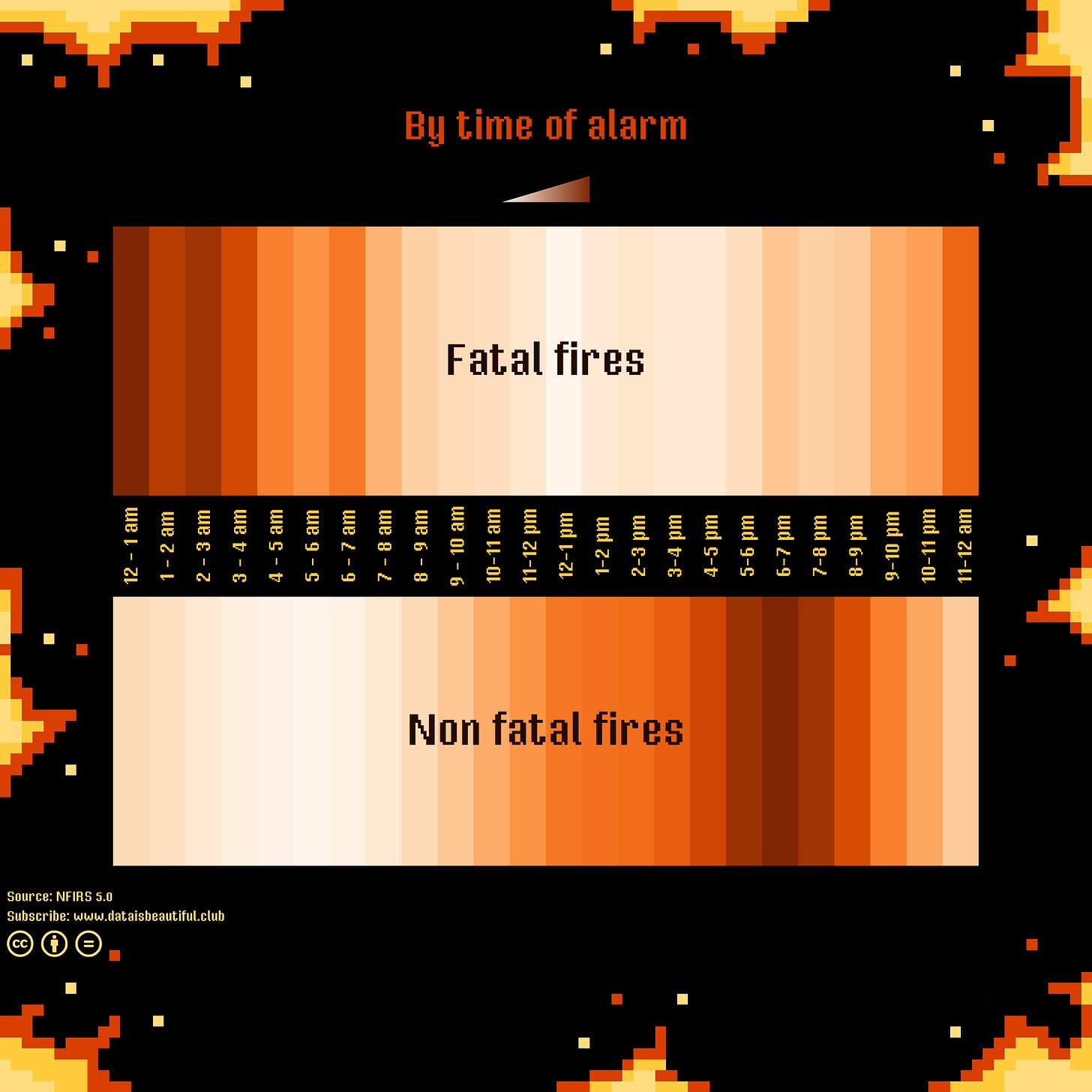Fire news everywhere! Be data driven
All information is w.r.t fatal fires in residential buildings and based on data from 2018-2020 by US Fire Administration
Fatal fires in residential buildings
Each year, from 2018 to 2020, an estimated average of 1,900 cases were reported to fire departments within the United States.
These fires caused an estimated annual average of:
2,745 deaths, 625 injuries, $239Mn in property lossHighest between midnight to 1 a.m. (7%).
More prevalent in the cooler months, peaking in January (14%).
“Other unintentional, careless” action was the leading cause (20%).
In 80% cases, the fire extended beyond the room of origin.
Most often started in bedrooms (27%) and common areas such as living and family rooms (26%).
The leading human factor contributing was being “asleep” (41%). When “asleep” was reported as a contributing factor to the fatal fires in residential buildings, “smoking” and “other unintentional, careless” actions were the leading causes.
Smoke alarms were not present in 24% of cases.
Automatic extinguishing systems (AESs), including residential sprinklers, were reported to have not been present in 90% cases.
Loss measures
Though making up less than 1% of all residential fires, fatal fires have devastating impacts. Data from 2018-2020 shows that these fires result in over 5 times the financial loss and 10 times the injury rate compared to non-fatal fires. Among fatal fires, 87% cause one death, 10% cause two, and 3% result in three or more fatalities, highlighting their severe consequences.
Average loss:
Fatalities/1,000 fires: 1,174.2
Injuries/1,000 fires: 243.4
Dollar loss/fire: $98,170
Property use
Most fatal residential fires (79%) occur in one- and two-family homes, where the majority live. Multifamily homes account for 15%, and other types like boarding houses and hotels make up the remaining 6%.
When fatal fires in residential buildings occur
Fatal residential fires most commonly occur late at night or early morning, peaking from midnight to 1 a.m. at 7%. The 11 p.m. to 7 a.m. window accounts for 45% of such incidents. They decline throughout the day, hitting a low of 3% from 12 to 1 p.m. Factors include people being asleep and unaware, and smoldering fires from cigarettes or careless actions growing unnoticed.
Fatal fires in residential buildings by month and day
Residential fatal fires are twice as common in cooler months, peaking in January at 14% and dropping to a low of 5% in August and September. These fires also occur more frequently on weekends, similar to non-fatal residential fires. Factors may include increased indoor activities during colder months.
Causes of fatal fires in residential buildings
The leading cause of residential fatal fires is "other unintentional, careless" actions at 20%, which includes various forms of misuse and neglect. The next most common causes are "under investigation" at 16% and "smoking" at 14%. In multiple-fatality fires, the main causes are similar: "other unintentional, careless" actions (20%), followed by "under investigation" (18%) and "electrical malfunction" (10%). These leading causes are also predominant in single-fatality fires, with rates of 20%, 16%, and 14% respectively. Notably, "other unintentional, careless" actions are more common in fatal fires (20%) than in non-fatal ones (8%).
Fire spread during fatal fires in residential buildings
Eighty percent of residential fatal fires spread beyond the room where they started, often occurring at night when people are asleep. The remaining 20% are contained to the origin room, highlighting that even small fires can be deadly.
NFIRS smoke alarm data for fatal fires in occupied residential buildings
In occupied residential buildings with fatal fires, smoke alarms were present in 34% of cases. In 24%, no alarms were there, and in 42%, it was unclear if an alarm existed. Of those with alarms, 16% were operational, 7% failed to work, and in 11%, their status was unknown.
When focusing only on incidents with alarms, they worked in 47% of cases, failed in 19%, and in 1%, the fire was too minor to trigger the alarm. In 33%, the alarm's status was undetermined.
At least 24% of these fatal fires had no smoke alarms, a number likely higher due to unreported data on alarms.
NFIRS automatic extinguishing system data for fatal fires in occupied residential buildings
In occupied residential buildings with fatal fires, only 2% had automated extinguishing systems (AES), mainly sprinklers, compared to 5% in non-fatal fires. Despite the benefits of sprinklers in reducing death, injuries, and property losses, many homes lack these systems. They are, however, commonly found in hotels and businesses, where they are often required by code. There's a growing movement in the U.S. to mandate sprinklers in all new single-family homes.
That’s a wrap! Share what you think about fatal fires on comments
Thanks for reading











